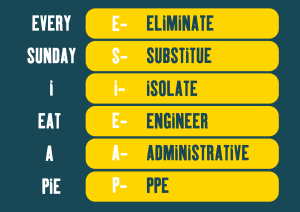
When it comes to working safely at heights, make sure you’re eating a pie every Sunday. Wait…what?
Yep, you heard that right.
Remember the phrase: Every Sunday I Eat A Pie. It’s a handy way to remember the steps for staying safe: Eliminate, Substitute, Isolate, Engineer, Administrative, and PPE. These steps help you figure out what safety measures to use when you’re working at heights.

No matter the height you are working at, you have to make sure that you are controlling the risks, it doesn’t matter if that work is 40mm from the next surface or 40m.
Just like people argue about the best flavour of pie, there are different ways to working safely at heights, choosing the best methods such as the following examples of controls will be based on your specific situation, and the work being carried out. .
Eliminate: Not everything that needs doing has to be done “up there”. What tasks can be done on the ground before you have to do it at height? Every step achieved where you don’t have a risk of dropping objects is a reduction of other things to concentrate on when at height.
Substitute: What other methods can be used to get to the workspace? Instead of a ladder could you use a scaffold? MEWPs (like scissor lifts & boom lifts) can be really handy here, not only with safe access but also with making it easier on your body to get there and work all day.
Isolate: This means to physically prevent the contact between you and the risk (falling or even dropped objects etc) this can come in the form of guardrails, scaffolding, or nets to prevent things or people from falling to lower levels.
Engineer: This is a more permanent solution, think of your handrails on staircases or cleverly built seats with high backs around the edges of a raised deck. It’s built for purpose and will continue to deliver that outcome without you having to interact with it (passive protection) this is often referred to as safety in design.
Administrative: This is simply making people aware. Think about hazard boards, signs, warnings, toolbox talks or paperwork to communicate what you will be doing, how, and who is doing it when.
PPE: This is the likes of harnesses to prevent you getting to a place you can even fall if possible, and if you do fall then to lessen the severity of the injuries you would receive from a fall if set up correctly, a hard hat to protect your head from small items falling like screws and small items etc.
It’s important you and your team are actively involved in ensuring any work carried out at heights, is done in the safest way possible. Empower your team to speak up, highlight unsafe working situations or practices, and swiftly act to handle them.
We recommend doing a Task Analysis to put a plan in place to manage the risks involved with working at height. This will help you decide whether it’s possible to eliminate the risk of falling from height or what the most effective control/s are to minimise the risk.
So from the above, what’s your favourite flavour combinations? Which ones will satisfy your cravings to keep the team safe today?
If you’ve got a question about working at height or any other health and safety matter, the HazardCo Advisory Team is here to help. Give them a call on 0800 555 339
Meeting your health and safety requirements shouldn’t be a chore. Instead, it should be an easy, functional and productive part of your day. With HazardCo, that is exactly what it becomes.
For a 7 day no obligation trial of HazardCo, just fill in your information and take control of your on-site Health & Safety.
